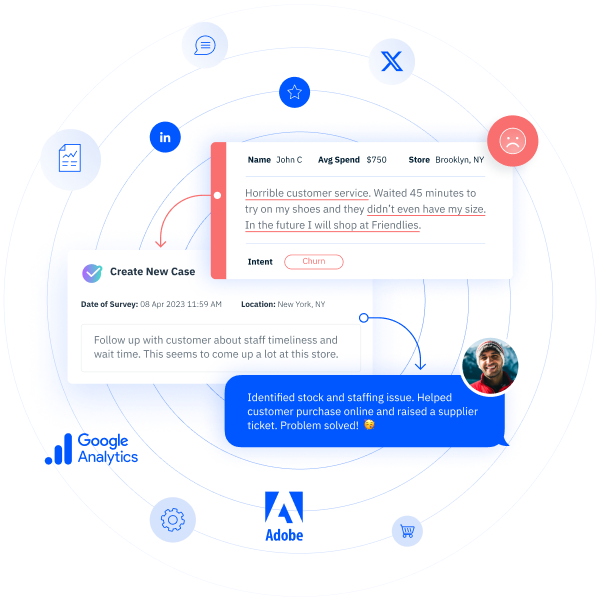How to Reduce Inbound Call Volume in a Contact Center Without Hurting CX
Find out how to ease call center pressure with CX-friendly tactics that deflect volume, improve satisfaction, and streamline operations.
Everything slows down when call volumes rise. Agents struggle to keep up, call queues grow longer, and customers waste little time looking for alternatives to your business.
Unless you’re expecting a seasonal spike, a high inbound call volume is far from good news. It’s usually indicative of operational issues, with negative consequences for agent wellbeing and customer satisfaction.
But the solution isn’t to throw more agents at the problem. It’s to eliminate unnecessary calls altogether. A strategic approach leveraging self-service technology and call analysis is key to lowering call volumes and achieving customer experience (CX) improvements.
What Constitutes a High Call Volume?
While there’s no universal benchmark for high call volume, every call center knows when it’s receiving more inbound calls than its staff can reasonably handle. In general, industry standards tell us that high call volume is 10% higher than the expected level for the team.
It’s also important to note that this surge in calls must persist for more than a week to qualify as high call volume. However, this figure (and the threshold mentioned above) can vary depending on the size and scale of your business.
When the volume of inbound calls continues to overwhelm agents for a sustained period, teams are vulnerable to burnout and struggle to lower wait times for customers. The result is poor agent and customer experiences that hinder business growth.
Why Reducing Support Call Volume Should Be a Priority
Businesses must reduce inbound calls as a strategic imperative to boost operations and provide better customer experiences at a lower cost. Here are three key benefits to consider:
Lower Operational Costs
Each call has a cost, since it requires time, staffing, infrastructure, and training for effective handling. Reducing unnecessary calls through automation or self-service options allows teams to redirect budget toward long-term improvements.
Increased Agent Productivity
Fewer calls mean fewer interruptions, better focus, and more time to solve complex issues. When agents are no longer dealing with repeat questions or avoidable contacts, they have enough breathing room to handle the calls that do come in with greater care and attention. This enhanced productivity leads to faster issue resolution and higher job satisfaction.
Improved Focus on High-Value Interactions
Not all incoming calls are created equal. When you reduce call volume, you give agents the bandwidth to invest their resources and emotional energy into impactful conversations. These interactions could include retaining frustrated customers or guiding someone through a critical decision.
Factors That Contribute to High Call Volumes
High call volumes are the result of customers running into roadblocks as they try to resolve their issues. While you can handle more calls by hiring more agents, you won’t be able to address the root cause of the problem if you neglect the customer’s perspective. The following factors explain why customers usually have no choice but to reach for the phone:
- Ineffective self-service options make it difficult for customers to address their problems themselves. If your interactive voice response (IVR) systems, chatbots, and FAQs aren’t up-to-date and helpful, your agents will be scrambling to resolve calls all day.
- Lack of proactive communication keeps customers in the dark and compels them to pick up the phone. A single timely update regarding issues or key changes can save many hours’ worth of call handling.
- Complex or confusing processes, such as unclear policies and vague instructions, will leave most customers scratching their heads. They will naturally follow up with your contact center for clarification and guidance.
- System outages or technical issues lead even the calmest customers to your frontline agents. Even if your services go down temporarily, it won’t be long before potentially upset customers start reaching out for updates and solutions.
- Product or service changes like new features and pricing updates can cause confusion (and inbound calls) if you don’t communicate them clearly.
- Lack of channel diversification means customers often can’t find the right answers through chat, email, or self-service options. A phone call to customer support becomes the only path forward.
- Seasonal spikes or campaigns are busy periods that bring a wave of new and existing customers with questions and complaints.
- Incomplete customer experiences in other channels are the result of an inadequate omnichannel system. Customers often escalate their issues through phone calls when questions are left unanswered on other channels.
10 Strategies to Reduce Call Volume in a Call Center
It’s easy to think that you can address high call volume through staffing changes. However, hiring more people is a temporary fix that fails to address the underlying inefficiencies responsible for recurring calls. Here are ten powerful strategies to implement for contact center optimization and customer retention.
1. Enhance Self-Service Options
Customers don’t want to wait on hold for information they can easily find themselves. But too often, help centers are either poorly organized, outdated, or buried in navigation menus. It’s no wonder, then, that 81% of the customers surveyed for InMoment’s 2025 Conversational Intelligence Report preferred brand interactions over self-service channels.
A well-built self-service experience gives customers fast and frictionless access to answers. For example, maintaining an up-to-date knowledge base ensures customers are in the loop regarding new product updates or better troubleshooting techniques.
Similarly, tap into your support tickets and call summaries to identify frequently asked questions (FAQs) around your product or service. Organize these FAQs in a user-friendly page, allowing customers to immediately find helpful answers.
Good self-service works because it empowers customers to independently resolve their issues. This ability has a positive impact on agent productivity as well, since they can spend more time and effort addressing complex tickets.
2. Implement Chatbots and Virtual Assistants
Some types of customer issues involve a few simple steps that one can perform without relying on live agents. For example, checking the status of an online product delivery or confirming if a restaurant is open.
Chatbots and virtual assistants offer a scalable way to automate these types of interactions. They’re available 24/7 and offer instant responses to FAQs and other basic customer inquiries, which is key for call center cost reduction and customer satisfaction. According to IBM’s Digital Customer Care in the Age of AI report, businesses can resolve up to 80% of routine questions using chatbots, which helps cut customer support costs by 30%.
As a result, agents are better able to focus on complex tasks requiring human judgment and emotional energy. On the other hand, customers get quick answers, avoiding the need to wait in call queues for a standard question.
3. Improve First Call Resolution (FCR)
When customers have to call back more than once to solve a problem, it creates unnecessary volume and damages trust. The negative impact of repeat calls makes First Call Resolution (FCR) one of the focal call center metrics for customer loyalty.
The first step is to analyze call center performance to identify your agents’ strengths and weaknesses. Use the insights to develop tailored coaching programs that empower each frontline support team member to put their best foot forward. Guide them toward actionable strategies that avoid unnecessary escalations and incomplete responses in favor of swift and comprehensive resolutions.
Besides the right training, agents also require access to tools, data, and documentation for this purpose. An easy-to-navigate knowledge base, along with a unified view of customer data, empowers agents to solve issues with confidence.
The payoff of FCR improvements is clear: fewer repeat customer calls, higher CSAT, and stronger feelings of brand loyalty. It also gives teams more time to handle new inquiries without falling behind or burning out.
4. Conduct a Repeat Call Analysis
Repeat calls from the same customer or regarding the same issue are indicative of flaws in the call resolution process. These calls account for a significant chunk of the total call volume, with a Dialpad case study discovering that 32% of inbound calls are from repeat callers.
As a result, managing repeat calls is crucial for lowering overall call volume. Repeat call analysis is the first step here, as it helps uncover areas for improvement in the call resolution process.
Start by analyzing your call data to identify repeat callers and recurring complaints within a specific timeframe. Dive into the insights to understand the root cause of these repeat calls. Use post-call surveys to understand specific customer needs and pain points.
Therefore, repeat call analysis helps flag training gaps and system limitations responsible for unnecessary volume. These insights enable teams to improve their scripts and agent coaching, which helps prevent similar follow-ups from piling up in the future.
5. Address Product or Service Friction
If your agents receive repeat calls about the same issue, you might want to take a closer look at your product or service. Maybe a feature isn’t working as intended, or it’s just confusing to use. Either way, every support ticket tied to a recurring issue is a signal that something upstream needs fixing.
Businesses should try to zoom out and identify the root cause of product or service friction, instead of troubleshooting the same problems. Are unclear instructions leading to setup questions? Is a billing process triggering complaints each month? Are customers struggling to complete an online task without support?
A cross-departmental effort involving product and marketing is also valuable here. It enables CX leaders to smoothly identify, fix, and communicate product issues and updates. As a result, customers stay in the loop, making it less likely that they will follow up about the same issue.
6. Monitor and Act on Feedback
Customer feedback is one of the most direct signals for a contact center to reduce inbound volume. When you keep your finger on the pulse of customer sentiment, you quickly spot the pain points leading to unnecessary calls.
Start by capturing feedback through surveys or post-interaction ratings. Layer that data with call summaries to identify trends. Identify the recurring issues that leave customers with no choice but to contact support agents. These issues could range from inadequate self-service to unclear product updates.
Act on the repeat call drivers once you understand them. Update your knowledge base, improve navigation, and implement better call center coaching techniques. Close the feedback loop with customers to ensure satisfaction and prevent further frustration.
7. Proactively Communicate with Customers
Proactive communication keeps customers in the loop, making it less likely that they reach out for clarification. If there’s an expected delay, a system outage, or a billing change, a well-timed message can stop hundreds of calls in their tracks. It also shows customers that your brand is transparent and reliable.
Create automated alerts for common service interruptions and updates. Ensure the messaging is clear, timely, and sent through the right channels. Don’t bury important notices in lengthy newsletters or inaccessible dashboards.
When you keep your customers informed, they are less likely to panic and reach out to the contact center. Proactive communication also supports online reputation management efforts, as customers are more likely to rate and recommend your business.
8. Streamline Onboarding and Product Education
One way to lower the number of repeat calls is to just improve your product onboarding process. The better your customers understand your product, the less likely they are to call the support team for answers.
As a result, it pays off to make product education part of your CX strategy. Offer guided tutorials, interactive walkthroughs, and bite-sized content that answers common questions. Video demos and setup wizards are also helpful resources for reducing confusion for new customers.
9. Use Conversational Intelligence to Spot Patterns
High call volumes provide opportunities to better understand your customers’ struggles and sources of frustration. This is where conversational intelligence comes in.
When you summarize and analyze call transcripts at scale, you can immediately identify common pain points. With the help of artificial intelligence, you can dig into the interactions further to surface agent performance gaps and shifts in customer sentiment. This information provides a valuable starting point for reducing call volume.
InMoment’s conversational intelligence software makes this process faster and smarter. It automatically summarizes call content, categorizes interactions by topic, and uses sentiment analysis to reveal instances of friction. These insights help teams prioritize what to fix, from digital experience issues to agent coaching opportunities.
10. Optimize Website and Mobile App UX
Your website and mobile app are often the first places customers visit when they are learning about your brand. Therefore, if essential information is difficult to find, they are more likely to reach for the phone.
With 56% of customers preferring to visit the website when researching a brand’s offering, optimizing the digital experience should be a strategic priority. Ensure that account information, order status, billing details, and support options are easy to locate and clearly explained. Work with your developers and UX designers to include a well-placed knowledge base or chatbot prompt. Improve your FAQ page to make it readable and easy to understand.
Regular usability testing can help you spot where real users struggle. The feedback helps you create a smoother customer journey that doesn’t rely on frequent calls for support.
Reduce call volumes and improve CX with InMoment
High call volumes are the result of inefficient workflows, poor agent performance, and little to no reliance on self-service technology. While it’s a pressing challenge for businesses looking to lower costs, it can be managed through a customer-centric approach. Enhanced self-service, root cause analysis of customer dissatisfaction, and proactive communication are key strategies for call volume reduction.
InMoment helps you take this one step further. Our AI-powered conversational intelligence software gives you real-time visibility into what’s driving calls, where friction exists, and how to fix it. From summarizing interactions to uncovering emotional insights, the tool transforms everyday conversations into clear and actionable opportunities for improvement.
Ready to reduce call volume without compromising the customer experience? Schedule a demo today and see how InMoment helps contact centers work smarter towards customer satisfaction!





